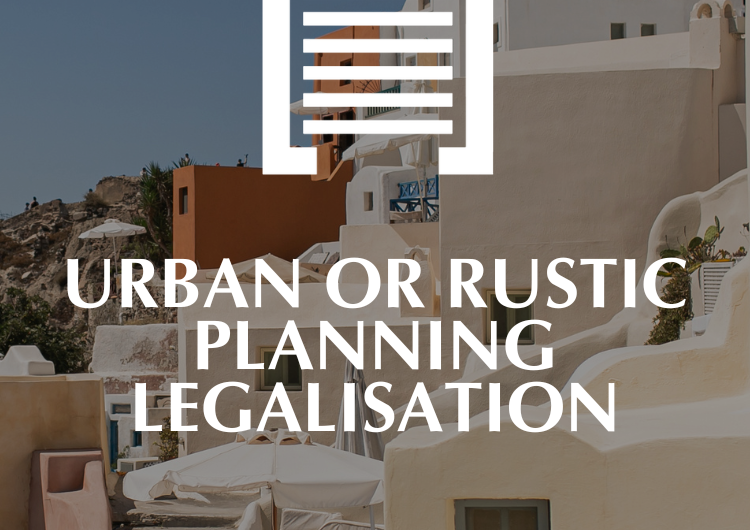
In this post we are going to deal with all the different steps that are required to carry out a purchase and sale with the maximum legal guarantees.
To do this, we will divide into different sections everything that must be taken into account from the intention of buying or selling a property to the exhaustion of all the legal post-sale guarantees.
Let’s start with the initial steps.
Initial steps
As initial steps we must take into account the nationality of the seller and the buyer and whether they are in Spanish territory.
As the legal act of purchase and sale is a taxable act, it is very important that the parties are fiscally identified.
Thus, if both parties involved or either of them is a Spanish citizen, with a Spanish National Identification Document (“DNI”), they will already be fiscally identified, as well as those legal persons who are Spanish, who will have a company CIF.
This is not the case for persons (individuals or legal entities) who are not Spanish nationals. In this case, it is necessary to distinguish whether they have a NIE or not.
If they have a NIE/NIF, they simply have to register, either electronically or in person, on form 030. This is so that they are duly identified in order to pay the corresponding taxes on the sale and purchase (the seller the profit and the buyer VAT or ITP, depending on the case).
Otherwise, as a preliminary step, it is suggested that the NIE/NIF be obtained. At this point, the procedure is different if the person is in Spanish territory or not.
If they are in Spanish territory (for example, because they are on holiday), they can do it themselves by making an appointment at the National Police, presenting the relevant forms with their documentation or by means of a power of attorney granted to a proxy to carry out the procedure on their behalf.
If the intervening party is outside Spain, in this case, an appointment must be made with the Spanish consular body closest to their home in order to carry out the same procedures as with the Police.
There is some controversy as to whether a power of attorney can be granted abroad, empowering a Spaniard to request the NIE from the Spanish authorities. Some police offices accept this and others require that the power of attorney must be granted in Spain.
At the same time, there is also controversy about the official translation: there are offices that accept double-column powers of attorney (translation done by the lawyer when preparing the draft) and certified by the notary, and other offices that expressly request an official translation of both the notarial extract and the apostille.
In order not to encounter any problems that may slow down the sale and purchase process, we recommend consulting with each police office.
This NIE/NIF will allow its holder to open a bank account in Spain without any problems (except in those banks that allow it to be opened only with a passport), as well as, in the case of the buyer, to obtain facilities to be able to arrange a mortgage and thus purchase the property.
However, the failure to obtain the NIE/NIF does not necessarily have to precede the signing of the sale and purchase, as the legal act can be signed as long as the NIE/NIF can be obtained within one month of signing, as this is the deadline for the corresponding taxes to be declared, subject to penalty fees.
If it is not possible to obtain a NIE/NIF within one month of signing the deed, you can apply to the tax authorities for a provisional tax identification number, known as an “M”.
In order to obtain the “M”, it will be necessary to prove the need for it by showing the documentation in which the interest in the tax identification can be seen. The “M” will allow us to register the person on form 030 and thus settle the corresponding taxes before the month has elapsed since the signature.
Once the corresponding identifications have been obtained so as not to have any problems in the middle of the process, we can start the next step: the beginning of the Due Diligence of the property to be transferred.
At Bufete Frau we have extensive experience in both national and international sales and purchases. Above all, in the case of a sale and purchase with an international component, let us advise you, we will accompany you throughout the process, paving the way for the sale and purchase.

Due Diligent Start
Once all the identification numbers of the parties involved have been obtained, the purchase and sale procedure is followed by the initiation of Due Diligence.
Due diligence is a procedure of checking documents related to the purchase and sale. The investigation is to find out whether what is being bought, what is being offered, and its physical description matches and corresponds to what is officially stated.
Thus, there are two basic documents that must be examined from the first minute of the game: the Nota Simple del Registro de Propiedad and the Certificado del Catastro.
From the Cadastre Certificate we will obtain the following very important data: perimeter of the property (extension), whether or not there are horizontal divisions within the property, land classification (urban, non-urban, rustic) and main use of the land.
This information is of utmost importance, especially in light of the purpose of the purchase: it is important to see what the land classification is in order to see if it matches the purpose of the purchase. It is not the same to purchase for residential use as it is to purchase for industrial or agricultural use.
Another important piece of information is the cadastral reference value. In sales and purchases, the cadastral reference value is required in order to know which is the basis for taxation: the purchase price or the cadastral value (whichever is higher).
It is important to note that there are properties that do not have a cadastral reference, so we must indicate this on the day of signing. In this case, it is offered to the buyer if he/she wishes to immatriculate the property (if he/she wants it to appear in the cadastre for the first time).
As far as the Nota Simple is concerned, the following data must be checked:
– Description: nature, location, cadastral reference, surface area. These data must coincide with the cadastral certificate.
– Ownership: we will see the name of the owner, his tax identification and what portion of the property belongs to him. Thus, it will be very important to check that the property is actually acquired by the seller. If the name of the seller does not coincide with the owner of the property, we must check whether the seller is acting under power of attorney and whether this power of attorney has been granted in accordance with all the corresponding legal requirements so that it is valid for signing the sale in the name of another person.
– Encumbrances: in the encumbrances we will observe how many rights in rem affect the property. There are three types of rights in rem: enjoyment, guarantee or acquisition.
Thus, in this department we will have to examine whether the property must support any easement (right of way, water…), or whether it is a guarantee of a credit whose collection belongs to a third party (mortgage, pledge or antichresis charge).
In such a case, the following payment must be put on the table: either there is a discount on the final price or the property is released.
In the case of a discount on the final price of the property, it is the buyer who repays the claim on behalf of the creditor. In this case, we are faced with the legal concept of subrogation, where the buyer is subrogated to (replaces) the seller as debtor, and this subrogation must be authorised by the creditor of the claim.
In the case of release of the property (i.e. that it is no longer a security for the claim), the seller must show us proof that he has satisfied the debt or at least that the property is no longer the security for payment of the debt. Another document of proof that we will ask for is an updated Nota Simple, so that it indicates “No encumbrances”.
- Pending filing entries: as the Nota Simple is the extract of the published legal acts, it is possible that there are legal acts filed and pending publication (15 days elapse from filing to publication). Therefore, as the Spanish registry system is one of the most reliable in the world, it even foresees if there are legal acts pending publication, in order to wait for the corresponding period and request a new, updated Nota Simple.
The Due Diligence must also consider, depending on the case, what kind of special regulations the property is subject to. It is not the same to acquire a property for an industrial activity with the transfer of an activity licence as it is to acquire a property where part of the land is classified as agricultural land.
And it will depend on the classification, its main use and the buyer’s intentions, if the chosen property is suitable for the desired purpose.
At Bufete Frau we are expert lawyers in Real Estate Law who, thanks to our extensive experience, know the documents that must be examined in order to be able to prepare a complete and rigorous Due Diligence with full guarantees of the content and characteristics of the property so that the buyer can make a better decision.
Purchase Option Contract, Promise of Sale, Earnest Money Contract and Pre-Contract
Having seen the start of Due Diligence and how the property to be acquired should be examined, if it passes all the above filters, it will be time to prepare the contracts.
There are four types of contracts prior to the conclusion of a sale and purchase: option to purchase contract, promise of sale and pre-contract.
The option to purchase contract is a contract of preferential acquisition.
It can either be an individual contract or incorporated into a lease. In fact, generally, in accordance with the Urban Leasing Act 29/1994 of 29 November 1994, tenants have a right of first refusal to purchase the rented property unless they expressly waive this right.
Generally, rental contracts exclude this right of pre-emptive acquisition, and, in the event that it is included, it is clearly determined whether the rental payment is on account of the final sale price or simply for the maintenance of the right of pre-emptive acquisition. A price can also be agreed in order to acquire the right of first refusal.
It should also be noted that the right of pre-emptive acquisition, as it is a right that encumbers a property, must be registered in the Land Registry.
The most important features of the contract or option to purchase agreement are as follows:
- It must be an expressly signed agreement in order to be registered in the Land Registry.
- The sale price for the acquisition of the property must be stipulated and, if applicable, the price that has been agreed to grant this option right.
- The period for exercising the option, which may not exceed four years.
However, in the case of a lease with an option to purchase, this right will last for the entire lease term, but will expire in cases of tacit or legal extension of the contract.
On the other hand, a contract of promise of sale is of a different nature. This type of contract implies that the seller undertakes to sell.
Thus, the contract of promise of sale is the other side of the coin of the earnest money contract, because it is the seller who undertakes to sell his property within a certain period of time, subject to a financial penalty in the event that he does not fulfil his reservation.
The earnest money contract is the pre-contract par excellence of the sale. It operates as an option to buy for the buyer and as an obligation to sell for the seller (redundancy aside).
Thus, this type of contract combines the two previous contracts, and its consequences are clearly regulated in the Spanish Civil Code: the buyer pays a sum of money (normally 10% of the value of the property) to ensure that the seller will sell the property to him on a certain date. In the event that the date arrives, if the sale is not concluded due to the buyer’s fault, he loses this 10% advance and, if it is not concluded due to the seller’s fault, the seller must return double the amount advanced, i.e., and following the usual practice, 20% of the value of the property.
Thus, the earnest money contract is a contract of guarantee and obligation: both parties guarantee each other and are obliged to sell and acquire the property.
The Pre-contract, on the other hand, is a legal figure that comes to guarantee a series of points to ensure the content of the purchase contract. Generally, the pre-contract becomes necessary when, prior to the conclusion of the contract, efforts and expenses must be made by one or both parties.
Thus, this figure establishes the costs to be incurred and how to compensate them in certain cases (cases agreed by the parties).
The purpose is to avoid that, in the event of non-conclusion of the sale, the injured party can be compensated without having to fight for his right and the amount, since all the extremes are fixed in the pre-contract.

Due Diligent Completion
As discussed in Chapter II, on the initiation and performance of Due Diligence in the purchase and sale of a property, this Chapter will deal with the final result of the technical and legal investigation carried out by an expert in Real Estate Law.
Of course, the review of the legal status and the geographical description of the property must yield a tangible result. The conclusions are then set out in a description, a technical-legal report, which is drawn up in accordance with the client’s needs.
Thus, the result will be called “Due Diligence Report“. The Due Diligence report will be complete and descriptive, indicating all the documents reviewed, identifying them one by one and setting out in writing the conclusions of each point resulting from the review.
In addition, all facts that may affect the buyer’s willingness to make a decision, as well as possible risks that he may run in the future, must be outlined. Therefore, as an annex to the Due Diligence there will be a list of the documentation reviewed as well as the descriptive sheets and other documents that have served as support for the preparation of the technical-legal valuation of the property.
Therefore, it should be noted that when a situation is observed that may involve future litigation, the client should be informed, as well as the procedure that should be carried out, its cost, time and assessment of the amount of the lawsuit, as well as the probabilities of its existence.
The main reason to carry out a Due Diligence is, without a doubt, to know exactly and precisely what it is that the client is acquiring, and, if he/she also wants it as an investment object, to know the probability of profitability.
A due diligence is therefore an individualised treatment of the statements and guarantees of the purchase and sale transaction.
Therefore, the moment to deliver the Due Diligence Report is without a doubt the moment before the signing of the deed of sale, because it will be the last study for the buyer to make a final decision on the purchase of the property.
Moreover, the result of the Due Diligence can lead to the conclusion of the sale, or initiate a period of negotiation to change the conditions, or even not to conclude the sale.
For this reason, at Bufete Frau we recommend that you put yourself in the hands of experts in Real Estate Law who, due to their extensive experience, can draw up the most precise and accurate Due Diligence in order to provide the client with all the necessary guarantees and recommendations in accordance with their requirements.
Signing the Deed of Sale
After completing the preparatory steps seen in Chapters 1, 2 and 3, we begin this chapter with the signing of the deed of sale.
1. Why a deed of sale before a Notary Public?
Why make a purchase and sale deed before a notary? The reason is that the guarantee offered by a public document (i.e. one whose signature has had the intervention of an authority or public official).
The deed of sale is a public document used to acquire a property that grants veracity and legal certainty to both the buyer and the seller, therefore, it becomes a guarantee for all the contracting parties and allows its inscription in the Land Registry.
The key point is that the buyer becomes the owner vis-à-vis all persons, and this effect is only achieved by the registration of the contract in the land register. As only public documents have access to the Land Register, it is highly desirable to acquire a finca by means of a deed of sale of finca, because such a deed proves that the act is authentic, legal and enforceable (it proves its content without further legal proceedings).
The signing of the deed of sale can be done in any notary’s office in Spain. It is not necessary that it is the place where the property is located.
Moreover, as a possibility, the buyer and seller can be in different places and sign the purchase and sale.
2. Essential documents for the purchase-sale
For the purchase-sale we will need several documents (collected during the Due Diligence) so that the Notary can proceed with the signature.
One very important thing is to know if the purchase is to be effected by the granting of a mortgage in favour of the buyer. In this case, we must ensure that the European Standardised Information Sheet (hereinafter “ESIS”) has been signed by the client at least 10 days before the signing (or, in some territories, 14 days).
The new mortgage law has brought with it important new features, including several types of documents such as the ESIS, which are designed to provide clarity and transparency to the customer.
The FEIN is the European Standardised Information Sheet, which is an official document that financial institutions have to give to customers who are going to apply for a mortgage loan with them.
In addition to the ESIS, there is another document that accompanies it, the FIAE (Standardised Information Sheet). This is another document that the financial institution also has to give to the customer that complements the ESIS. It includes information on more financial aspects of the mortgage.
Both documents must be given to the client, and he/she must affirm before a Notary that he/she knows, knows and understands the conditions of the mortgage.
Having said this, the documents that must be provided to the Notary for the signing of a purchase-sale are: the Nota Simple, the Cadastral Certificate, the Energy Efficiency Certificate, the Certificate of the Community of Owners, if applicable, the Certificate of Habitability, the last IBI and any other documents that, due to the circumstances of the case, may be necessary. For example: the power of attorney (when acting by proxy) or the NIE (in the event that one of the parties is a foreigner).
Once the deed of sale is signed by the parties, it is time to go to the cashier’s office.
3. What are the costs and who pays them?
The act of sale itself entails the following costs:
- Notary fees: Notary fees, known as tariffs, are regulated by the state and all notaries charge the same for the same services. In the case of the execution of the public deed of sale, the prices vary according to the price of the property, being established between 0.3% and 0.5% of the property.
- Land registry fees: These fees are also set by the State and their price depends on the value of the property. Generally, they range from 400.-€ to 650.-€.
- Taxes:
-
- New construction, first transfer: the property will be taxed with a 10% VAT and a percentage of 0.4% to 1.5% of IAJD (Actos Jurídicos Documentados) depending on the Autonomous Community.
- Used property, second or subsequent transfer: the property will be taxed with ITP with a percentage of 4% to 10% depending on the Autonomous Community.
- Gestoría: expenses for the liquidation of taxes and the follow-up of the insertion of documents in the Land Registry.
Who pays it? According to the Civil Code, the costs of the first copies are assumed by the seller, and all other costs are assumed by the buyer, unless otherwise agreed.
Therefore, generally, all the aforementioned expenses will be paid by the buyer.
At Bufete Frau, we have extensive experience in carrying out deeds of sale, both nationally and internationally. To ensure a purchase in the best hands, do not hesitate to count on our help and services.

Post-Purchase Service
In principle, when a property is purchased with a lawyer as an intermediary in the transaction, there should not be any subsequent problems that would require a legal service after the purchase.
However, this does not mean that nothing will ever happen. In the cases in which there is a problem in the post-sale it is, in the majority of cases, due to a lack of information expressly omitted or the appearance of an unknown damage in the property, in such a way that it was not foreseen or could not be foreseen in the moments before and at the time of the purchase and sale.
In the case of faults or defects concealed (but not hidden) by the seller, depending on how they affected the property and their relevance, we can request the nullity of the sale due to an error of will, as there was an erroneous knowledge of the essential conditions of the object or its transmission.
However, in the case of hidden defects (i.e., which neither of the parties knew about and which could not be known except through the passage of time), the guarantees that accompany the buyer are different.
In the case of hidden defects, the Civil Code allows us to demand their repair from the seller if they become apparent within 6 months of purchase.
Now, what is a hidden defect?
A hidden defect is any type of defect, uncompleted/unfinished work, or a fault, which, despite existing at the time of sale, was not apparent, and is therefore not perceived by the parties and is therefore called “hidden”.
For example, a hidden defect is a problem with the water drainage system, which causes dampness in the property and therefore makes it uninhabitable. It can also be the foundation, which manifests itself through cracks and fissures. Or a problem with the insulation of the property, in which case you will only know when you live there and notice that the noise and temperatures make the property uninhabitable.
We can only demand the guarantee for hidden defects when their seriousness prevents you from living normally in the house or when it is manifestly clear that, if you had seen or known about them, you would not have bought the property, or you would have bought it, but for a lower price.
In these cases, the responsibility clearly lies with the seller.
Once the defect has been detected, it is essential to proceed with the following steps in order to prevent the 6-month period from elapsing (and thus be out of warranty).
The first step is to make an economic valuation of the defect, and this is done by means of an expert report, or at least by an expert in the field. Once this valuation is available, the seller is informed of the situation and the value of the damage, in order to find an amicable solution.
If it cannot be settled amicably, then we start the steps to initiate litigation. The first mandatory step is the sending of a burofax (as this is a reliable proof that there has been prior notice and an attempt at amicable termination). In the event that there is also no agreement between the parties as a result of the sending of a burofax, the next step is to file a lawsuit claiming the economic valuation of the hidden defect.
Therefore, in these cases it is especially important to have the assistance and advice of a Lawyer, because there are only 6 months for the seller to respond to these defects, so that the past ones must be duly determined and adjusted to the Law as much as possible, in order to ensure the success of a possible lawsuit demanding the economic cost of repairing the defects.
However, after the term of 6 months, it does not entail the loss of rights on the part of the buyer, but the way of claiming liability towards the seller will be because the object of the sale (the property) is different to what the buyer thought he was signing, thus urgin the contractual nullity. It is a more difficult route whose success is more volatile than the previous case.
Therefore, at Bufete Frau we recommend that any sign of damage to the property should be reported immediately in order to provide the exact legal advice corresponding to the needs of the case.
- NEWS OF URBAN OR RUSTIC PLANNING LEGALISATION - May 27, 2024
- NEW DEVELOPMENTS IN THE NEW HOUSING LAW - September 19, 2023
- DIGITAL NOMAD VISA SPAIN - August 9, 2023







